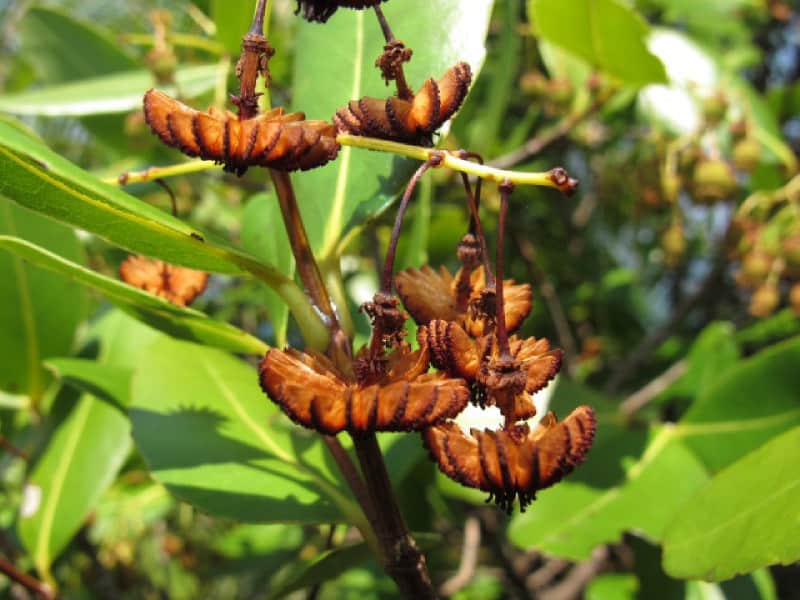
Jellyfish Tree Facts
- The highly evocative term of the Jellyfish Tree serves as the most frequently used common name for an extremely unusual type of tree. Its official scientific name, however, remains that of the all but unpronounceable Medusagyne oppositifolia.
- Regardless of which of these particular terms one chooses to use for it, this remarkable flora stands out for a most unfortunate reason. In point of fact, this fascinating tree currently ranks as one of the rarest known species of tree on earth.
- Researchers had, in fact, previously believed this marvel of Nature to be extinct. Then, to the sincere amazement of those same researchers, a chance discovery of a handful of specimens took place in the early 1970’s, exciting botanists worldwide.
- Presently, only around 30 known specimens exist in the wild, within an incredibly tiny area. Quite understandably, the IUCN currently lists the amazing Jellyfish Tree as Critically Endangered. This status appears on the organization’s Red List.
- Since its population remains so terribly small, as well as its remaining zone of habitation, one danger it faces comes from potential habitat loss. Its greatest threat, however, may now come in the form of the ongoing effects of climate change.
Related Articles
Jellyfish Tree Physical Description
Although the fabulous Jellyfish Tree does impress those individuals fortunate enough to encounter it, it does not do so due to sheer size. Somewhat surprisingly to some, this highly distinctive tree only ranks as a moderate-sized variety of tree.
Exceptional specimens attain measured heights of as much as 33 ft (10 m). Most individuals, however, remain somewhat smaller than that. It also develops a thick canopy, composed of densely interlocked, slightly elongated foliage, with a dark green color.
These leaves themselves, in fact, typically reach lengths equaling around 3.1 in (8 cm), and have a thick, leathery texture. The thin trunk of the tree develops a comparatively distinctive bark, displaying a dark color, along with deep, interlocking fissures.
The tree also bears both male and female flowers which develop small in size and white in color. Like Medusa, arguably the fruit represents its most unusual aspect. Its distinctive shape truly is remarkable, since it bears a strong resemblance to a jellyfish.
The fruit of the fascinating Jellyfish Tree also merit attention and appreciation for their distinctiveness. These develop with a rounded shape, like many fruits, and displaying a bright green color. This later changes to reddish-brown as it ages.
- Kingdom: Plantae
- Phylum: Angiosperms
- Class: Eudicots
- Order: Malpighiales
- Family: Ochnaceae
- Genus: Medusagyne
- Species: M. oppositifolia
Jellyfish Tree Distribution, Habitat, and Ecology
Quite regrettably, the distinctive Jellyfish Tree only inhabits an extremely limited and restricted area of the world. For the moment, researchers have found no evidence that the marvelous plant ever existed anywhere outside of its current, tiny zone of habitation.
More precisely, the fabulous flora only appears on the tiny tropical island of Mahe. This island itself forms the main island of the Seychelles, considered as part of the continent of Africa. Even there, however, it only resides within a very tiny niche in the ecosystem.
Not only does that qualify as tiny, but the very nature of that exact habitat serves to further complicate its efforts to survive, let along to spread. In fact, all known specimens appear within 1.2 mi (2 km) of the sea, and grow in the cracks of exposed granite outcroppings.
This, understandably, appears to be severely hampering the survival efforts of the Jellyfish Tree. The few seeds produced by the surviving, mature trees, either fall on pure stone, thus having no chance to germinate, or find themselves quickly blown out to sea by the winds.
Although theories abound, one leading theory proposes that those tress alive today actually represent the outlying members of its original population. The idea is that invasive species in its original habitat, wherever that was, overtook the others.
Species Sharing Its Range
Check out our other articles on 5 Rare Mind-Blowing Cloud Types, Long Eared Owl, Gorges du Tarn, European Mantis, Indian Giant Squirrel, Chinese Giant Salamander, Gila Monster
